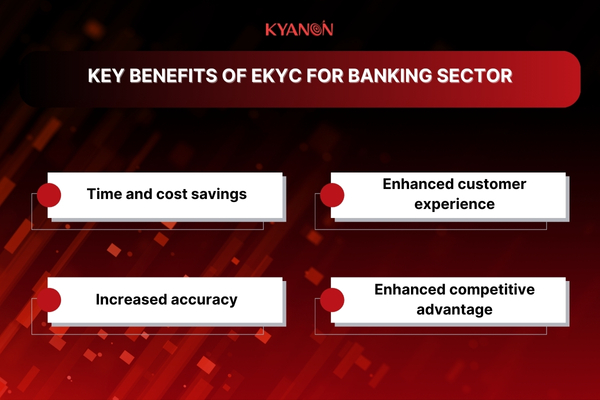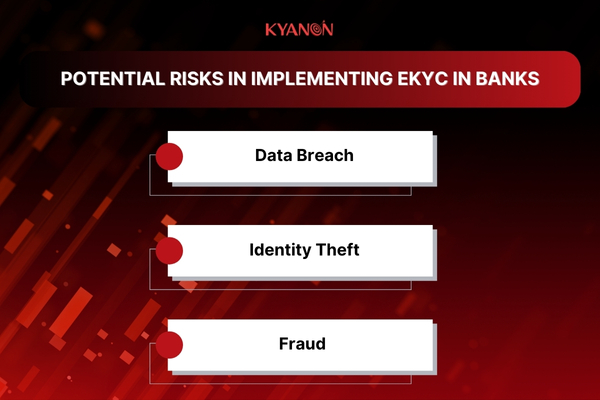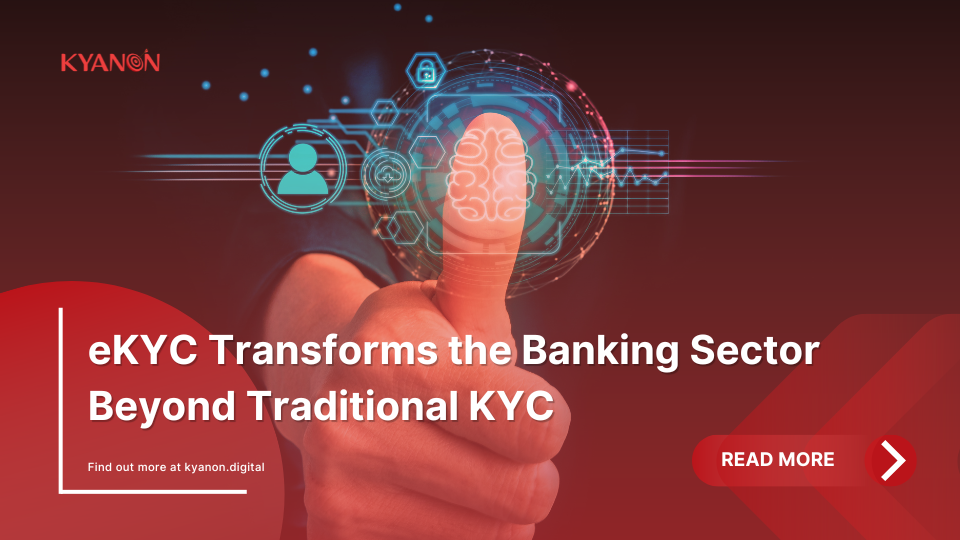In today’s digital era, KYC is a crucial process that helps banks verify identities and ensure financial security. However, with technological advancements, traditional KYC is gradually being replaced by eKYC—an electronic version that simplifies customer verification, reduces time and costs.
eKYC not only enhances user experience but has also become an essential trend in the digital transformation of the banking industry.

1. What is KYC?
KYC (Know Your Customer) is a process employed by banks and financial institutions to verify the identity of customers. The main objective of KYC is to ensure that these organizations are dealing with legitimate individuals or entities, thereby minimizing risks related to fraud, identity theft, money laundering, and terrorism financing.
In the traditional KYC process, customers are required to submit documents such as identity cards, utility bills, and income proof. These documents are then thoroughly checked, accompanied by direct verification, in which customers must visit a bank branch to validate their identity.

KYC is not only a tool for protecting the financial system but also helps banks effectively assess and manage risks. This process ensures compliance with Anti Money-Laundering (AML) and Counter-Terrorist Financing (CTF) regulations, contributing to global financial stability.
2. What is eKYC?
eKYC (Electronic Know Your Customer) is a strong digital transformation from the traditional KYC process, allowing banks to verify customers quickly and conveniently through online platforms. Instead of relying on paper documents and face to face meetings, eKYC enables financial institutions to verify customer identities entirely electronically, providing superior efficiency and high security.

The eKYC process consists of three main steps:
- Online Identity Verification: Customers enter personal information through a secure online system, including details such as name, address, and identification number.
- Submitting Electronic Documents: Customers simply upload personal documents in digital form, such as passports or driver’s licenses.
- Biometric Authentication: Many eKYC systems also integrate biometric authentication methods, such as facial recognition and fingerprints, to ensure the person performing the verification is indeed the individual being declared.
With its rapid processing speed, the eKYC process shortens verification time, allowing customers to access financial services much faster. Additionally, the convenience of eKYC also enables customers to verify their identities from home without needing to visit the bank. Thanks to remote verification capabilities, this process can occur anywhere, expanding service reach and optimizing customer experience. For banks, eKYC reduces costs through the automation of manual steps, alleviating operational and staffing burdens. In summary, eKYC revolutionizes the verification process, enhancing satisfaction and operational efficiency in the banking sector.
3. What Makes eKYC Different from Traditional KYC
While both methods are used for verifying customer identity, KYC and eKYC still have significant differences.
Criteria | KYC | eKYC |
| Verification Process | Customers must visit the bank for direct verification. Bank staff manually checks documents and confirms the customer’s identity. | Customers can complete the process remotely via digital platforms without face to face meetings. |
| Document Submission | Customers must submit paper documents, such as passports or IDs, at the bank and wait for manual processing. | Customers can easily upload digital documents, which are automatically verified by the system, faster and more accurately. |
| Processing Time | Delays and lengthy processing due to manual verification requirements. | Realtime identity verification significantly shortens processing time. |
| User Experience | The KYC process is cumbersome and inconvenient, requiring customers to visit the bank and wait for approval. | eKYC offers a quick, convenient, and streamlined experience for users. |
4. Key Benefits of eKYC for Banking sector
- Time and cost savings: eKYC significantly shortens customer onboarding processes, reducing verification time from several days to just a few minutes. This not only saves time for the banks but also lowers operational costs.
- Enhanced customer experience: Customers can complete the identity verification process anytime and anywhere without visiting the bank. This convenience both improves experience and allows the banks to serve a broader audience.
- Increased accuracy: eKYC utilizes artificial intelligence (AI) and biometric technologies, such as facial recognition, to enhance accuracy in the verification process. These technologies help detect fraud quickly and efficiently.
- Enhanced competitive advantage: eKYC allows banks to differentiate themselves from competitors, attracting new customers and retaining existing ones by satisfying their needs in the digital age.

5. How eKYC Enhances Security and Compliance in Banking
5.1. Potential Risks in implementing eKYC in Banks
- Data Breach: The digital nature of eKYC makes data susceptible to theft during cyberattacks.
- Identity Theft: Sharing personal information online can lead to identity theft if appropriate protective measures are not in place.
- Fraud: Criminal actors may exploit weaknesses in the eKYC process to impersonate legitimate customers or create fake identities.

5.2. Security Measures of Banks Implementing eKYC
- Data Encryption: Banks use robust encryption techniques to protect sensitive data during transmission and storage, ensuring that information remains safe even if intercepted.
- MultiFactor Authentication (MFA): Requiring multiple forms of verification (such as passwords, SMS codes, biometric data) enhances security and makes unauthorized access more difficult.
- Biometric Authentication: Utilizing methods like facial recognition and fingerprint scanning adds an extra layer of security, ensuring that only authorized individuals can perform transactions.
eKYC is designed to comply with global Anti Money-Laundering (AML) regulations. These regulations require banks to verify customer identities to prevent illegal activities such as money laundering and terrorism financing. eKYC helps banks meet these requirements effectively.
6. The Global Rise of eKYC in Banking and Financial Services
eKYC is becoming a global trend as banks strive to improve customer experience and optimize processes. In India, the Aadhaar system—a unique identification number issued by the government—has enabled ICICI Bank to implement eKYC, allowing customers to open accounts remotely in just minutes.
In Europe, regulations such as GDPR and PSD2 not only ensure data security but also encourage the expansion of digital identification solutions, enabling banks like BNP Paribas to successfully implement eKYC.

Countries like Singapore, Malaysia, and Thailand are actively promoting eKYC. For example, the Monetary Authority of Singapore (MAS) has issued specific guidelines to encourage financial institutions to adopt eKYC, significantly improving customer onboarding processes, of which DBS Bank is a prominent example. Other regions, such as the Middle East and Africa, are also gradually implementing eKYC to promote financial inclusion.
The legal frameworks in these countries play a vital role in ensuring that eKYC not only improves operational efficiency but also fully complies with security and privacy standards, laying the groundwork for the widespread application of this technology in the future.
7. The Future of eKYC in the Banking Sector
The future eKYC in the banking sector will be strongly shaped by technological advancements. The integration of AI, blockchain, and biometric technology promises to enhance efficiency and accuracy in the eKYC process. AI can quickly analyze data to detect fraud, while blockchain secures customer information safely. Biometric methods like facial recognition and fingerprint scanning will further strengthen security.
As eKYC becomes more widely adopted, customer onboarding processes will become faster and more convenient. Customers will gain immediate access to banking services, improving the overall experience. In the next decade, eKYC is expected to lead to a more personalized banking experience. At the same time, regulatory compliance and security will remain a priority, helping eKYC become the standard in the banking industry.

In summary, KYC requires direct verification and relies on paper documents, while eKYC uses digital technology to optimize the process, ensuring safety and enhancing customer satisfaction. As the banking sector continues to evolve, the implementation of eKYC becomes increasingly important and necessary. In this way, banks not only improve customer experience and reduce costs but also maintain competitiveness in an ever evolving digital world.
If your bank is looking to enhance customer onboarding processes with eKYC solutions, Kyanon Digital is your trusted partner. Contact Kyanon Digital today to optimize your processes, enhance customer experience, and ensure full compliance with the industry regulations.


